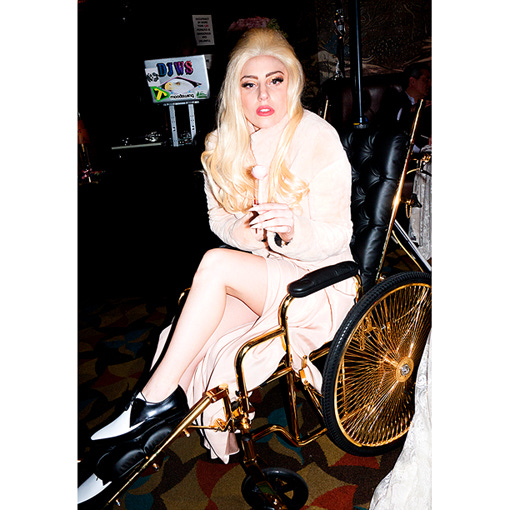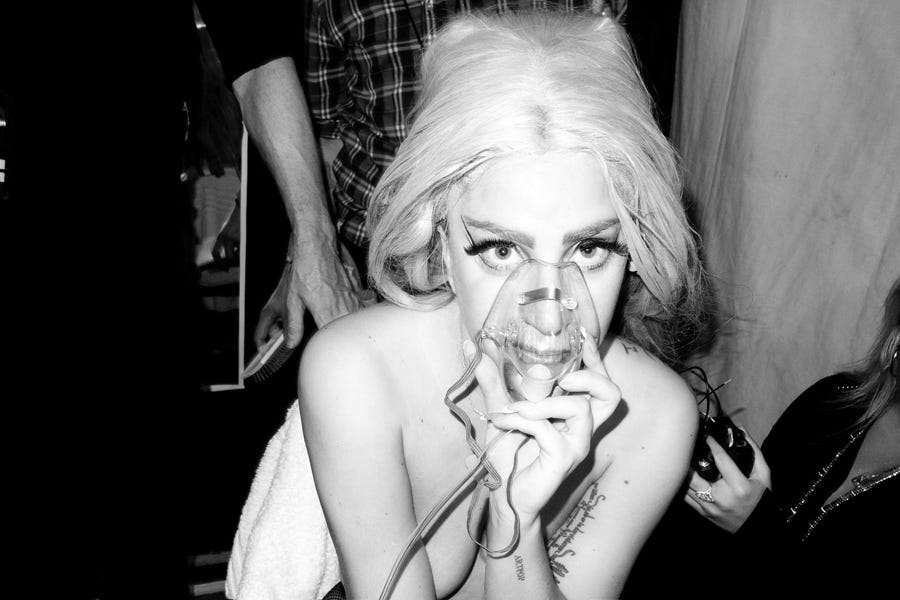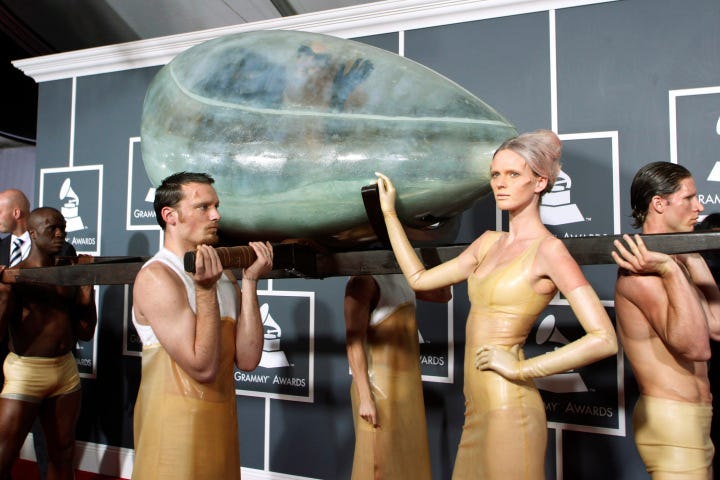There Will Never Be Another 'Born This Way'
The promotional campaign for Lady Gaga's third album set a standard for herself that she could never meet again — and that's a very good thing.
Lady Gaga realized that she had a mission. After the massive success of her first two albums, The Fame and The Fame Monster, the pop phenom whose ascent had already been the fastest of the new millennium had reached a point where she felt a deep calling to make her next project greater than herself. Her newfound level of fame and mega popularity with both fans and the general public meant that she had carte blanche when it came to her next album. For Gaga, that meant striking while the iron was hot and people were listening to create something unquestionably important in a time when public perception of queer rights was finally beginning to see a major shift. “I knew I had an ability to change the world when I started to receive letters from fans,” she told (the now-defunct) RWD magazine in September 2010. “[Fans would write,] ‘You saved my life...,’ ‘I'm gay and my parents threw me out.’ My fans have related to me as a human being and as a non-human being — as a super-human person that I truly am.” At the MTV Video Music Awards that same month, Gaga swept the show, making her platform clear to anyone watching that may have had residual doubts about her fervent values. Accompanying her were four soldiers who had been formally discharged by the Don’t Ask Don’t Tell policy which Gaga had spent months trying to repeal by using her growing cache to lobby senators. After winning the biggest award of the night, the VMA for Video of the Year, Gaga announced the name of her new record, Born This Way, and sang a bar of the title track’s chorus. The hype for her third album was officially on…eight whole months before it would be released into the world.
In 2010, it sometimes seemed as if Gaga’s claims of superhumanity may have been true. Still in the middle of her sold-out, 10-leg, 203-show Monster Ball tour, she had already been writing and recording Born This Way while out on the road in both studios across the world and makeshift ones on tour buses during late nights on the way to the next gig. “My friends tell me that I recharge like a robot,” she said in a Vogue cover story. “I sit in my clothes, perfectly still, head straight up, and I just sleep.” With a schedule that was as rigid as it was physically demanding, Gaga found ways to maintain, all in service of her fans and her music. If she was compromising during this time, you couldn’t tell. The energy and the passion for what was to come were contagious, fans could feel every iota of anticipation for the next era emanating from Gaga. In her pursuit for fame, artistry, and impact, she made herself accessible to the public in a way that no other pop star of her generation had done yet. Born This Way would be about taking that relationship, that mutual understanding, and channeling it into music that spoke to a greater sense of purpose. It would be something that fans could listen to and feel like they were really understood — in some cases, for the first time in their lives. “If you have revolutionary potential, no matter who you are, it’s your moral obligation to try to make the world a better place,” she told an interviewer from T4 Sunday during a promo stop.
To spread this music and its ideas to as many people as possible, Gaga and her team at Interscope devised a long, arduous, grueling, and incredibly successful promo campaign, unlike anything anyone had done before. The mission was to make both her and the message inextricable from the public eye. Not only would Gaga be continuing to tour the world until just three weeks before the album’s eventual release on May 23, 2011, but she would maintain a promotional schedule alongside that for the five months leading up to it.
At the stroke of midnight on New Year’s Day 2011, Gaga tweeted out the official release dates of the album and lead single. Just over a month later, the first major tentpoles of the Born This Way album campaign were put in place: an early single release followed by a Grammy performance two days later. Already a hotly anticipated event, Gaga managed to defy expectations for the thousandth time by arriving on the Grammy red carpet being carried in a Hussein Chalayan-designed “vessel,” which she had reportedly been incubating in for three days, a detail that she was adamant about.
From that moment, Gaga was simply inescapable. For an artist who had already managed to saturate global headlines for the last two years, the coverage she received during the Born This Way campaign was both unexpected and unparalleled. There were music videos for “Born This Way” and “Judas”; covers of Vogue, Harper’s Bazaar, NME, i-D, V, Billboard, Time Out, and more; four installments of her behind the scenes YouTube video diaries called Gagavision; performances on Saturday Night Live, The Ellen DeGeneres Show, Oprah, American Idol, Good Morning America, and The Graham Norton Show, among others; a collection of highly publicized talk show interviews; collaborations with FarmVille, Starbucks, and Google, all while doing the final 41 shows of a sold-out world tour and all before the album had officially dropped. The post-release promo structure was no different. More videos, more interviews, more magazine covers, more live performances, more everything.
“I want to give my fans nothing less than the greatest album of the decade,” she told Vogue. “I don’t want to give them something trendy. I want to give them the future.” Fans ate it up. Gaga’s insistence on breaking down the barriers between the fan and the artist while delivering the most message-driven, political music of her career so far resulted in a sense of deep connection for millions of people. There was nothing like being a Lady Gaga fan in 2011. I was there, I remember what it felt like: electrifying and remarkable, like waking up to a direct deposit of serotonin every morning — not just because your favorite artist was on a talk show or a magazine cover again, but because the messages they were spreading while doing it were so life-affirming. Gaga fans were spoiled by the Born This Way campaign. She set a new precedent and standard for pop album rollouts, giving the world so much because she felt called to. But Gaga was so focused on the impact she could have on others that she didn’t get a chance to stop to think about the impact it would have on herself.

So often in the earlier years of her career, when asked about the driving force behind the music, Gaga always came back to the fan. “I want to continue to be a better artist, for..….for them,” she said in her T4 Sunday interview. Rarely would the conversation turn inward. Even when Gaga discussed the inspiration behind Born This Way’s most anthemic songs like “Hair,” “Bad Kids,” and the title track, Gaga would cite her own traumas that she had grappled with throughout her life, but always repeated that she wanted to take those experiences and write about them so anyone going through similar trials could find some comfort. Born This Way helped both Gaga and her legions of fans work through issues that had once seemed too sizable to confront, the album’s extensive promo tour feeling like months of free therapy from the world’s most fashionable psychiatrist.
Gaga once described looking out at her audience of fans on tour as seeing a room full of “teeny tiny little mirrors.” “I got to see myself in the fans and they made me realize all sorts of things about myself that I had been afraid of for so long,” she said on T4 Sunday. But there’s a difference between seeing your experiences reflected in others and actually making an effort to work through those experiences outside of the lights of an arena. Gaga saw it as her calling to help those who were like her, often at the expense of her own health. There were things to do, music to promote, a team to pay, lives to change. To touch as many as possible, she kept going, going, and going. Once the promotional cycle was over, there were only brief periods of rest between an Album of the Year nomination at the Grammys, starting up her own charitable foundation with her mother, and then going back out on another sold-out world tour. While the lives of fans were changing, Gaga’s was staying the same: overworked and exhausted, but driven by her goal to change the world. She was beginning to run the risk of becoming a martyr for her message.
Jimmy Iovine, the then-president of Interscope, told Vogue that, “Her talent will take her as far as she wants to take it. Most artists of this caliber, if they can stay healthy, there’s no limitation. None.” Except that’s the thing: staying healthy is the limitation. And it’s a necessary one for survival.
It wasn’t until February 2013, during the final stretch of the Born This Way Ball, that her body forced her to stop. After concert video footage captured her in visible pain during a Montreal performance of “Scheiße,” the last song of the night, fans knew something was wrong. So did doctors, who insisted that the rest of the tour’s dates be canceled for Gaga to receive immediate surgical treatment for a labral tear in her right hip.

Gaga’s recovery allowed for her first extended break in over four years. Plans for ARTPOP, her fourth studio album, were pushed back until late summer. When Gaga re-emerged with an album full of hardcore EDM tracks that took on heady subjects like rape, drug addiction, and autonomy, it was immediately clear that time off had turned her perspective inward. She was struggling with serious pain, both physical and mental, and this time it couldn’t be placated by the screams of adoring fans. Nevertheless, Gaga kept trying to top herself — she had to, the staggering success of Born This Way’s year-long campaign set a precedent for what label executives thought she could do. ARTPOP’s promo campaign had to be bigger, crazier, and more outrageous than Born This Way’s. But it was inimitable. The strategies and ideas that felt exciting for one album became polarizing for the next. With the heart at its center hurting deeply, everything fell apart at the seams. There was a flying dress that barely lifted off the ground, two scrapped videos, controversial collaborations, a tearful award show performance, and a split with her longtime manager Troy Carter. Two months after ARTPOP’s release, the promo campaign fizzled out with a couple of live performances, a second music video, and a tour. It looked as if Gaga might have been swallowed by the pop music machine. She had spent so long trying to find the traumas from her own life reflected back at her so she could ease them for others that she never took the time to address them in herself.
“I just all of the sudden became a star and was traveling the world going from hotel room to garage to limo to stage,” she told Oprah Winfrey six years later at Winfrey’s 2020 Vision Tour. She was speaking to Winfrey about mental health, a subject she had been passionate about for her entire career, the one she tackled most prominently on Born This Way but had neglected to examine on her own. After ARTPOP, Gaga began working with a new team and at a slowed pace. And while she was addressing her own trauma more seriously, she still was still in immense pain. “I never dealt with it,” she told Winfrey. “And then all of the sudden, I started to experience this incredible, intense pain throughout my entire body that mimicked, actually, the illness that I felt after I was raped.”
In the years between the labral tear in her hip that forced her to slow down and the top of 2020, Gaga worked with teams of doctors to find the source of excruciating, global pain she was experiencing. What she eventually discovered was that the trauma she experienced when she was sexually assaulted by a producer at age 19 had manifested itself in the brain as a physical response that induced head to toe, chronic pain. “I just didn’t stop moving,” she told Winfrey. “I just was moving and moving and working and working and dancing through insurmountable pain.” When Winfrey asked how long she lived that way, Gaga revealed that it was her life for about five years.
Now that she has been able to target the source of her chronic pain, Gaga works with a neuro-psych team to constantly address her health and maintain a relative state of wellness. She says that the practice of radical acceptance has helped her through this process, it’s part of how she functions every day while grappling with global pain, along with prescribed medications. Because of the pain, Gaga can no longer do bombastic world tours or extensive promotional campaigns. Her Joanne World Tour had to have its final dates canceled in 2017 after complications arose. For her most recent album, 2020’s Chromatica, Gaga and her team crafted a promotional rollout that would suit her physical and mental demands and planned a shortened, six-date stadium tour across major cities in the US and Europe. When the pandemic hit, everything had to be canceled, rescheduled, or retooled. Many fans felt robbed of a proper era, one that seemed to promise that it would be the biggest and most successful since Born This Way. When Gaga released Chromatica with as much fanfare as possible — still grappling with chronic pain, which she says can often be triggered by extreme stress — many still weren’t satiated. An entire album, three videos, multiple magazine covers, and an award show performance, all during a pandemic, weren’t enough. For some, the relationship between fan and artist had devolved into one based on greed. Too much was never enough. The inescapable nature of Born This Way became something they demanded every time around, with no concern for Gaga’s own mental and physical constraints. Ironic, since Born This Way is all about her steadfast concern for everyone else.
There will never be another Born This Way. And that’s a good thing, because it means that the woman at the heart of it knows how to take care of herself first now — something that anyone who felt touched by the album’s messages would deeply want for the person who made it. The fans who understood and were impacted by Born This Way the most don’t align with the groups of fans that demand more until there’s nothing left to give. Seeing Gaga thrive in the way her most influential album taught them to do is more than enough. We know that the point of Born This Way was to instill power and confidence and love of oneself. The album gave them — well, us — mental health self-sufficiency that we still carry a decade later. That’s why Born This Way is so remarkable: it’s not just an album, it’s a bible. It’s a tome and a guidebook for how to carry on, a gift imparted by someone who was struggling deeply but didn’t know it yet, only knowing that she felt called to give her message to millions of others before she began to really heed it herself. It’s a once-in-a-lifetime project, so special in its own right that it can’t even really be compared to the rest of Gaga’s extensive and excellent body of work. It’s her masterpiece. It’s her magnum opus.
Happy 10th anniversary, Born This Way.






